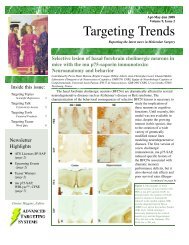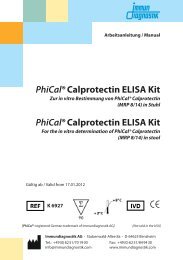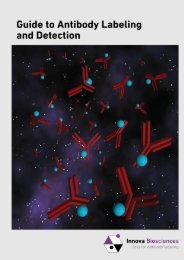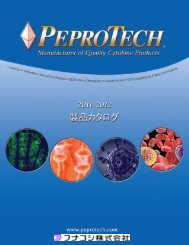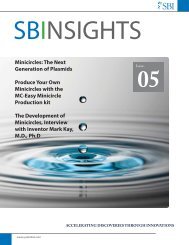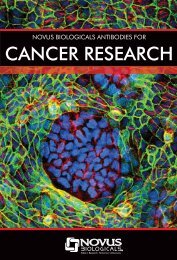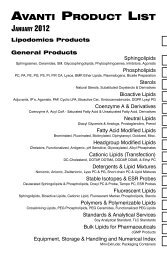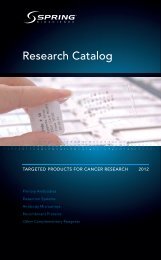Thermo Scientific Pierce Crosslinking Technical Handbook
Thermo Scientific Pierce Crosslinking Technical Handbook
Thermo Scientific Pierce Crosslinking Technical Handbook
You also want an ePaper? Increase the reach of your titles
YUMPU automatically turns print PDFs into web optimized ePapers that Google loves.
<strong>Crosslinking</strong> Applications<br />
<strong>Crosslinking</strong> applications<br />
Cell surface crosslinking<br />
Crosslinkers are often used to identify surface receptors or their<br />
ligands. Membrane-impermeable crosslinkers ensure cell-surfacespecific<br />
crosslinking. Water-insoluble crosslinkers when used at<br />
controlled amounts of reagent and reaction time can reduce<br />
membrane penetration and reaction with inner membrane proteins.<br />
The sulfonyl groups attached to the succinimidyl rings of<br />
NHS-esters result in a crosslinker that is water-soluble,<br />
membrane-impermeable and nonreactive with inner-membrane<br />
proteins. Therefore, reaction time and quantity of crosslinker<br />
are less critical when using sulfo-NHS-esters. Homobifunctional<br />
sulfo-NHS-esters, heterobifunctional sulfo-NHS-esters and<br />
photoreactive phenyl azides are good choices for crosslinking<br />
proteins on the cell surface.<br />
Determination of whether a particular protein is located on the<br />
surface or the integral part of the membrane can be achieved by<br />
performing a conjugation reaction of a cell membrane preparation<br />
to a known protein or radioactive label using a water-soluble or<br />
water-insoluble crosslinker. Upon conjugation the cells may<br />
be washed, solubilized and characterized by SDS-polyacrylamide<br />
gel electrophoresis (PAGE) to determine whether the protein of<br />
interest was conjugated. Integral membrane proteins will form a<br />
conjugate in the presence of a water-insoluble crosslinker, but not<br />
in the presence of water-soluble crosslinkers. Surface membrane<br />
proteins can conjugate in the presence of water-soluble and waterinsoluble<br />
crosslinkers. <strong>Thermo</strong> <strong>Scientific</strong> <strong>Pierce</strong> BASED (Product<br />
# 21564), a homobifunctional photoactivatable phenyl azide, is one<br />
of the more versatile crosslinkers for the study of protein interactions<br />
and associations. It is cleavable and can be radiolabeled with<br />
125<br />
I using <strong>Thermo</strong> <strong>Scientific</strong> <strong>Pierce</strong> Iodination Beads (Product<br />
# 28665). After cleavage, both of the dissociated molecules will still<br />
be iodinated. Because both reactive groups on this crosslinker are<br />
nonspecific, the crosslinking is not dependent on amino acid composition<br />
for successful conjugation.<br />
Cell membrane structural studies<br />
Cell membrane structural studies require reagents of varying hydrophobicity<br />
to determine the location and the environment within a<br />
cell’s lipid bilayer. Fluorescent tags are used to locate proteins,<br />
lipids or other molecules inside and outside the membrane. Various<br />
crosslinkers, with differing spacer arm lengths, can be used to<br />
crosslink proteins to associated molecules within the membrane to<br />
determine the distance between molecules. Successful crosslinking<br />
with shorter crosslinkers is a strong indication that two molecules<br />
are interacting in some manner. Failure to obtain crosslinking with a<br />
panel of shorter crosslinkers, while obtaining conjugation with the<br />
use of longer reagents, generally indicates that the molecules are<br />
located in the same part of the membrane, but are not interacting.<br />
Homobifunctional NHS-esters, imidates or heterobifunctional NHSester/photoactivatable<br />
phenyl azides are commonly used for these<br />
procedures. Although imidoester crosslinkers (imidates) are watersoluble,<br />
they are still able to penetrate membranes. Sulfhydrylreactive<br />
crosslinkers may be useful for targeting molecules with<br />
cysteines to other molecules within the membrane.<br />
<strong>Thermo</strong> <strong>Scientific</strong> <strong>Pierce</strong> EDC (Product # 22980, 22981), waterinsoluble<br />
dicyclohexylcarbodiimide (<strong>Thermo</strong> <strong>Scientific</strong> <strong>Pierce</strong><br />
DCC, Product # 20320) and other water-soluble/-insoluble coupling<br />
reagent pairs are used to study membranes and cellular structure,<br />
protein subunit structure and arrangement, enzyme:substrate<br />
interactions, and cell-surface and membrane receptors. The hydrophilic<br />
character of EDC can result in much different crosslinking<br />
patterns in membrane and subunit studies than with hydrophobic<br />
carbodiimides such as DCC. Often it is best to attempt crosslinking<br />
with a water-soluble and water-insoluble carbodiimide to obtain<br />
a complete picture of the spatial arrangements or protein:protein<br />
interactions involved.<br />
Subunit crosslinking and protein structural studies<br />
Crosslinkers can be used to study the structure and composition<br />
of proteins in samples. Some proteins are difficult to study<br />
because they exist in different conformations with varying pH<br />
or salt conditions. One way to avoid conformational changes<br />
is to crosslink subunits. Amine-, carboxyl- or sulfhydryl-reactive<br />
reagents are used for identification of particular amino acids or for<br />
determination of the number, location and size of subunits. Short- to<br />
medium-spacer arm crosslinkers are selected when intramolecular<br />
crosslinking is desired. If the spacer arm is too long, intermolecular<br />
crosslinking can occur. Carbodiimides that result in no spacer<br />
arm, along with short-length conjugating reagents, such as aminereactive<br />
<strong>Thermo</strong> <strong>Scientific</strong> <strong>Pierce</strong> DFDNB (Product # 21525) or the<br />
photoactivatable amine-reactive crosslinker <strong>Thermo</strong> <strong>Scientific</strong><br />
<strong>Pierce</strong> NHS-ASA (Product # 27714), can crosslink between subunits<br />
without crosslinking to extraneous molecules if used in optimal<br />
concentrations and conditions. Slightly longer crosslinkers, such<br />
as <strong>Thermo</strong> <strong>Scientific</strong> <strong>Pierce</strong> DMP (Product # 21666, 21667), can also<br />
crosslink between subunits, but they may result in intermolecular<br />
coupling. Adjusting the reagent amount and protein concentration<br />
can control intermolecular crosslinking. Dilute protein solutions and<br />
high concentrations of crosslinker favor intramolecular crosslinking<br />
when homobifunctional crosslinkers are used.<br />
For determination or confirmation of the three-dimensional<br />
structure, cleavable crosslinkers with increasing spacer arm<br />
lengths may be used to determine the distance between subunits.<br />
Experiments using crosslinkers with different reactive groups may<br />
indicate the locations of specific amino acids. Once conjugated,<br />
the proteins are subjected to two-dimensional electrophoresis. In<br />
the first dimension, the proteins are separated using non-reducing<br />
conditions and the molecular weights are recorded. Some subunits<br />
may not be crosslinked and will separate according to their individual<br />
molecular weights, while conjugated subunits will separate<br />
according to the combined size. The second dimension of the gel is<br />
then performed using conditions to cleave the crosslinked subunits.<br />
The individual molecular weights of the crosslinked subunits can<br />
be determined. Crosslinked subunits that were not reduced will<br />
produce a diagonal pattern, but the cleaved subunits will be off the<br />
diagonal. The molecular weights of the individual subunits should<br />
be compared with predetermined molecular weights of the protein<br />
subunits using reducing SDS-polyacrylamide gel electrophoresis.<br />
To order, call 800-874-3723 or 815-968-0747. Outside the United States, contact your local branch office or distributor.<br />
3



